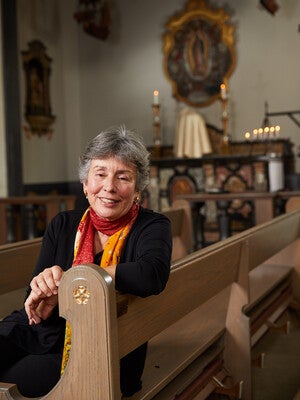In Conversation
Theologian Teresa Berger on the power of digital worship in our times

Yale Divinity School’s Teresa Berger was studying the power of digitally mediated practices of worship long before the COVID-19 pandemic closed houses of worship and sent celebrants online.
In 2018, Berger published “@ Worship: Liturgical Practices in Digital Worlds,” a study of the ways old and new spiritual practices have flourished online, and in her 2012 book, “Liturgy in Migration: From the Upper Room to Cyberspace,” she wrote of digital phenomena such as live-streamed liturgical celebrations, virtual prayer chapels, memorial sites, and pilgrimages.
Berger, professor of liturgical studies and the Thomas E. Golden Jr. Professor of Catholic Theology, spoke with YaleNews about community and spiritual health in a time when many are not able to attend to their normal faith rituals. Interview condensed and edited.
What drew you to study the phenomenon of digital worship?
Christian ritual practices had begun to move into forms of digital mediation across a variety of different media platforms some years ago. My scholarly field was still reacting to these migrations of ritual practices into digital forms in starkly negative ways. But, I wasn’t so convinced by this posturing, because I found a lot of these statements were born out of people having never actually experimented with digitally mediated worship practices. So I began rethinking how to theorize these practices. Nobody of course could foresee, at that point, the incredible surge of worship practices that went online within days of the emergence of COVID-19.
Some years earlier, digitally mediated worship had already been forced on me because of an illness. I spent all of Holy Week and Easter celebrating masses with Pope Francis on my couch. He was in Rome, of course, and I was sick as a dog at home. But joining in these liturgical celebrations in the Vatican, I thought, “This is certainly better than nothing.” After all, who would want to just be cooped up sick and unable to go to worship during the high holy days? So, this for me was a really intriguing experience with digital mediation, and one example of how rich an experience that could be.
What are some examples you’ve seen of how the digital world has expanded to encompass the Catholic tradition?
This past year, I taught a class on digital media and liturgy. Students were given the assignment to follow some Christian ritual practice through digital mediation. One of the students took up a project studying a rosary that is digitally mediated through an app. It’s a string of beads, but instead of you having beads in your hands, the app moves you through beads that you touch on a screen and they light up. You don't have to have the beads themselves in your hand. You have a smartphone in your hand.
Also, many experiences of sacred music are now available online; think of the wealth of meditative music videos out there. And we are seeing a deluge of religious ritual practices going online, both musical and liturgical. Under COVID-19, a vibrant discussion also emerged in some Christian communities about the Lord’s Supper, the Eucharist, in digital mediation. And several years ago, there were earlier experiments with what were called Twitter communions or internet baptisms. We are now in a time period where these are increasingly relevant discussions, as spiritual leaders and individual worshippers are looking to digital media to engage with what might otherwise have been done in person or in a community gathered in a brick-and-mortar sanctuary.
How can digital media help us think about death during this time?
Under COVID-19, one ritual receiving a lot of attention is, of course, funerals. This past semester I taught a course called “In the Face of Death: Worship, Music, Art” with a Yale colleague of mine who is a musicologist, Markus Rathey. As a class, we talked a lot about the history behind such practices in the Christian tradition as accompanying the dying, burying the dead, and remembering those who have gone before. COVID-19 is now throwing us into new conversations about these ancient practices. .
As we studied the historical development of religious practices “in the face of death,” one thing students noted early on was how community-oriented the process of dying, and of accompanying a person who was actively dying had been. For example, a community might gather to sing or read, or just be present with a dying person, until and beyond the moment of death. There used to be a ritual washing of the dead person’s body and then accompanying the person who had died to the cemetery, where rituals of remembering the dead took place. These were communal practices in the face of death, many of which had been lost long before COVID-19. But as a result of the pandemic, we have witnessed both a heightened isolation of a person facing death And at the same time, space has opened up for conversations around issues of dying and death and what might constitute a “good death.”
In the United States, the majority of people today die in medical settings and/or alone. COVID-19 has multiplied this number because of the fear of contagion and the necessity to isolate the very sick. At the same time, new paths have been forged to connect people during this time of social distancing, quarantine, and isolation. I am thinking here of live-streamed worship services, or of how priests can Skype with someone in isolation at the hospital to lead that person through their last moments of life in prayer. During this time of COVID-19, death can be even more lonely than it already is. Technology is opening new ways to connect us, digitally, and this is stretching the limitations of earlier faith practices, even those associated with dying and death.
Media Contact
Bess Connolly : elizabeth.connolly@yale.edu,